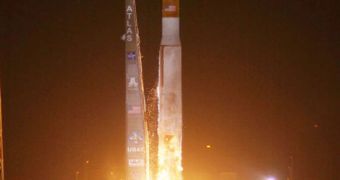NASA and the United Launch Alliance (ULA) have recently signed an unfunded Space Act Agreement, under which the private enterprise will analyze the possibility of converting its renowned Atlas 5 delivery system into a platform for launching astronauts into space.
ULA is a joint venture between the Boeing Company and Lockheed Martin. It currently handles all launches for the US Air Force (USAF) and is a very important player on the rocket market. The Atlas 5 platform has an excellent track record, too.
Under the new contract, ULA engineers will take a look at this rocket could be upgraded in order to support the launch of astronauts to low-Earth orbit (LEO), and especially to the International Space Station (ISS).
Engineers at the private enterprise will collaborate tightly with colleagues at NASA. The experts will provide feedback, analysis and reports to each other, trying to determine the exact nature of the challenges associated with transforming the Atlas 5 into a manned platform.
This does not mean that the delivery system itself will be converted into a manned spacecraft. Rather, NASA is contemplating the possibility that the rocket could be made to fit one or more of the private, reusable vehicles currently under development at other companies.
Centennial, Colorado-based Sierra Nevada Corp. and Kent, Washington-based Blue Origins are both companies that are developing spacecraft capable of reaching LEO and the ISS. Both are also strongly considering the Atlas 5 as a means of launching their vehicles.
In its role as a contractor for NASA, Boeing is also interested in the rocket for the space vehicle the company is developing. George Sowers, the vice president of business development at ULA, says that the rocket is growing increasingly popular among spacecraft manufacturers.
“The Atlas 5 appears to be the vehicle of choice for the commercial spacecraft providers. We didn't make that choice for them, they made that choice,” the official said on July 18, in a news briefing.
“I am truly excited about the addition of [the United Launch Alliance] to NASA's Commercial Crew Development Program team,” NASA Administrator Charles Bolden said in a statement.
“Having ULA on board may speed the development of a commercial crew transportation system for the International Space Station, allowing NASA to concentrate its resources on exploring beyond low-Earth orbit,” the top NASA official explained.
There is currently a great deal of excitement associated with this contract. Some ULA officials believe that the first modified Atlas 5 could fly within 3 to 4 years, at a time when private companies are also expected to finish building their spacecraft, Space reports.
But this goal is ambitious, analysts observe. Even if everything goes smoothly, the United States will remain without access to space for the next few years, after the shuttles are retired in a few days.
“We're taking steps to continuing on with being leaders of human spaceflight. It's a good day for commercial crew programs, good day for ULA, and good day for Americans,” added the manager of the NASA Commercial Crew Development program, Ed Mango.

 14 DAY TRIAL //
14 DAY TRIAL //